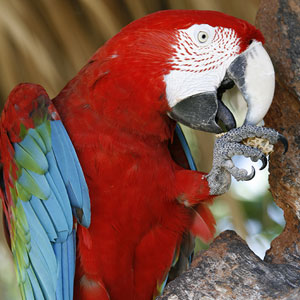
How to Switch Your Bird From Seeds to Pellets
You only want what is best for your bird, so providing him with the necessary nutrition is essential. Extruded food or formulated diets offer excellent nutrition and are often recommended by veterinarians. Although beneficial, switching from a seed diet to a formulated diet can be very difficult.
Why Convert to an Extruded Food?
Extruded foods are an excellent choice because they offer complete nutrition for your bird and contain a lower fat content, minimal dust, and low bacterial counts. The extruded food process involves "cooking" various ground ingredients by forcing them through a tube with steam and pressure. The "cooking" process helps break down the fats and starches, which in turn, improves digestion and also makes the food very palatable. Palatability is especially important when you are trying to convert your bird to a new diet. The cooked food is then forced through special dye shapes, loaded up with the right balance of vitamins, minerals, natural enzymes, and fat; then cooled. FruitBlend® With Natural Fruit Flavors is a great example of a healthy and balanced option for your feathered friend.Tips for Successful Feed Conversion
If you are debating switching your bird to a new diet, it is best to consult with your avian veterinarian first. Your vet can examine your bird and see if he is healthy enough for a diet change. They can also give the best guidance concerning which formulation to use and whether or not supplements will be necessary.After you know that your bird is healthy enough for a diet change, you can determine which method of conversion is best for your bird. One method to making a successful conversion to extruded food is to mix your bird's "old" diet with the "new" diet in a single bowl. Then gradually reduce the "old" diet and increase the "new" diet daily over a period of four to six weeks. New foods should be introduced in the morning because birds are most hungry when they first wake up. Young birds sometimes prefer the pellets to be moist, but make sure to remove any uneaten pellets after a few hours to avoid bacterial growth.
Another method to a successful conversion is to take your bird out of his cage and spread different brands of pellets on a flat surface. Try not to focus on your bird; instead, let him see you inspecting the pellets. If he sees you foraging through the pellets and "trying" them, he will be more willing to give them a try, as well.
During the conversion process, be sure you observe your bird eating and make sure he is passing feces in his droppings of adequate volume and consistency. Periodically weigh him or check the muscle on both sides of his keel bone to make sure he is not losing weight. Birds are very good at concealing illness so it's important to be vigilant during your diet-converting process. Be aware that once a bird starts eating pellets, his droppings will likely change color and consistency. Birds usually drink more water while eating a formulated diet, so it is common for their droppings to be looser.
As always, be sure to keep his food supply fresh and his water supply clean and ample. The key to successfully changing your bird's diet is to be patient. The health benefits of a well-balanced diet are worth the wait!
Discover More!
Feeding Your Bird: Seeds vs. PelletsTips for Feeding Your Bird
Pet Bird Nutrition
Return to Bird Articles


